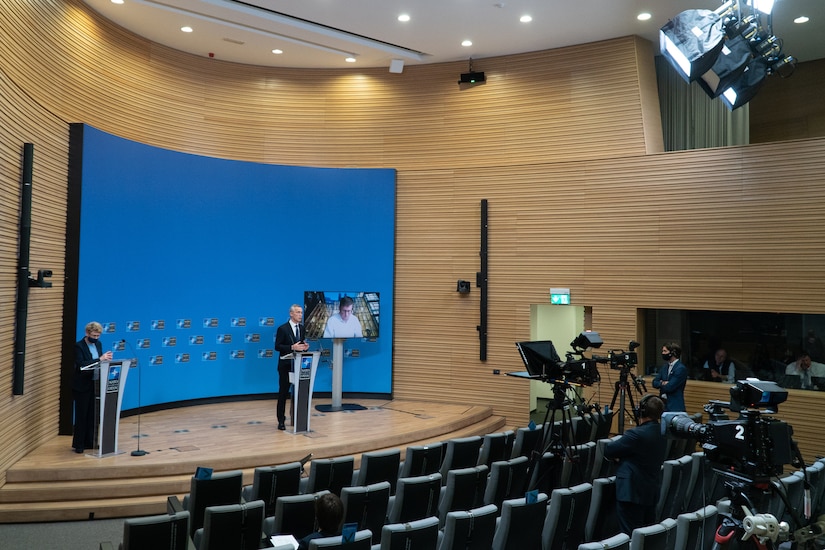Remarks as Delivered
Thank you, Marc. Before I begin, I’d like to address an important
issue: the reports of horrific attacks on Asian Americans across the
country. I want to be clear here: No one in America should fear
violence because of who they are of what they believe. Period. These
types of attacks have no place in our society. We will not tolerate any
form of domestic terrorism or hate-based violent extremism, and we are
committed to putting a stop to it.
I want to thank you for taking the time to be with us today. It’s
good see familiar names and for those of you I don’t know yet, I look
forward to meeting and working with you in the days and weeks to come.
I am pleased to be joined today by my good friend and law school
classmate, Assistant Attorney General for National Security John Demers;
and FBI Assistant Director for Counterterrorism Jill Sanborn. I have
known Jill as well for years. I even worked with her when I was at the
Department before. She is hard-nosed, detail-oriented, and I can’t
imagine someone better suited for the job. She is the first woman to
hold the position, and it’s a well-deserved promotion after a long and
successful career with the Bureau, both in the Counterterrorism Division
and in the field.
Today, I am going to discuss briefly the Department’s enhanced
response to domestic violent extremism and domestic terrorism, and then I
am going to turn the stage over to Jill and John to provide additional
remarks and take some questions.
When I left the Department as Assistant Attorney General for National
Security in October of 2016, the threat from violent extremists, both
international and domestic, was rising.
But, I never expected that just over four years later, when I
returned to the Justice Department to be sworn in on my first day as
Acting Deputy Attorney General, that to get to the building, I would
have to pass through numerous checkpoints under escort of armed agents
in a city under lockdown. I never expected to have to walk through the
Department of Justice hallways filled with hundreds of soldiers
positioned to protect the Department from terrorists. But I did.
Our mission is simple. That is not acceptable, that is not America, and it will not happen again.
The first briefing that I received in my new job was about the effort
to bring the perpetrators of the January 6 attacks to justice and
prevent future violent attacks.
The investigation into those responsible is moving at a speed and
scale that is unprecedented, and rightly so. Those responsible must be
held to account, and they will be.
I receive daily updates on the Capitol case investigation, at least
daily. And as of last night, over 300 individuals have been charged in
connection with the events of January 6th, and over 280 have been
arrested.
Just this week, I had an opportunity to spend more than an hour with
members of the prosecution team. They are committed, they are
determined, and they will keep us safe from the threat of violent
extremism.
The threat, of course, is bigger than any one event, no matter how
horrific. It can include not just efforts to disrupt our government —
like those on January 6 — but also efforts to intimidate or terrorize
our neighbors and members of our community based only on who they are
and what they look like. And as I mentioned at the top, all we need to
do is look at recent footage from New York and California to see those
horrific attacks directed at Asian Americans, to realize how dire the
threats are. We must return to an America where no one fears violence
because of who they are or what they believe.
To do so, we must make it known that the Department of Justice is
prioritizing the detection, the disruption, and deterrence of the threat
of domestic terrorism and violent extremism in all its forms. Now,
this is something, as with challenges in the past, that we can’t do
alone, but we have to do with partners, particularly our partners in
state and local law enforcement. Together, we will tirelessly pursue
justice for all of victims of violent extremism. Judge Garland made
that clear this week during his confirmation hearing, and I want to
reiterate it today.
While the rise of domestic violent extremism is a serious and growing
public safety and national security threat, unfortunately violence
motivated by extremism, hate, intolerance, and racism has been a
persistent and tragic occurrence throughout American history.
Our Department of Justice was formed to bring justice, and that means
battling terrorists, extremists, and hate. That has been true since
its beginning, when our first Attorney General led efforts to protect
our country from the threat of white supremacists, successfully
prosecuting hundreds of cases against members of the Ku Klux Klan.
Today, with the threat persistent and evolving, the Justice Department is keenly focused on how we can meet this moment.
Fortunately, both Judge Garland and Lisa Monaco, the Deputy Attorney
General nominee, have significant experience leading the Department’s
efforts on domestic terrorism matters, and the Department’s dedicated
career agents and prosecutors will continue to work around the clock to
disrupt the threat and keep Americans safe.
Before turning it over to John and Jill, I wanted to talk about three
specific commitments we are making in this area: following the data and
intelligence, protecting civil liberties and taking an all tools
approach.
FOLLOWING DATA AND INTELLIGENCE
On the first, we will confront this challenge, as we have for years
since September 11, using an intelligence-led, threat-driven approach
grounded in data and intelligence assessments of career experts.
The Department’s approach will be informed by the comprehensive
threat assessment examining domestic terrorism that President Biden has
asked the Director of National Intelligence to undertake, in
coordination with the FBI and others in the intelligence community.
The National Security Council is also seeking to determine, how can
the government better share information, support efforts to prevent
radicalization, disrupt violent extremist networks, and more?
The Department is participating in that process across a broad range
of components – including not just our National Security Division, who
you will hear from today, and our Criminal Division, but also the Civil
Rights Division, the Tax Division, the Office of Justice Programs and
the Bureau of Prisons.
As part of our data-driven response to domestic terrorism, we plan to
issue updated guidance in the coming days that will help make sure the
National Security Division has insight into, and can track, all cases
with a nexus to domestic terrorism or domestic violent extremism.
We know that information developed in one investigation may be the
key to saving lives because of another district’s investigation
thousands of miles away.
Information-sharing allows all of us to anticipate legal and
practical questions before they emerge and maximizes our ability to
collectively respond to present and emerging domestic threats, no matter
where they arise.
By collecting this data, we will be in a stronger position to take an
empirical, evidenced-based approach to domestic terrorism across our
work.
PROTECTING OUR CIVIL LIBERTIES
Our second commitment is to be steadfast in maintaining our commitment to civil liberties.
The FBI, as you will hear, very deliberately uses the term “domestic violent
extremism” in this area to emphasize that FBI investigations must be
predicated on criminal violence and other criminal conduct – never on
someone’s First Amendment beliefs or associations.
TAKING AN ALL-TOOLS APPROACH
Our third commitment is to take an “all-tools” approach to combatting
domestic terrorism – just as we have with other significant national
security threats.
The term “all-tools approach” was used often during my time at the
FBI and the National Security Division as we developed and described a
new approach to address international terrorism and national security
cyber threats.
This approach recognizes that success is not the prosecution of a
violent extremist or terrorist after the fact, when families have lost
loved ones or are grieving, but that success is the disruption before
violence occurs, and that always has to be the goal of our
counterterrorism work
Since starting back at the Department, I have convened the Domestic
Terrorism Executive Committee, an interagency group started after the
Oklahoma City bombing. In fact, it was a group that was scheduled to
meet on the morning of September 11. It did not meet that day and our
focus turned, for a period of time, to international terrorism. But as
we’ve seen the growth of domestic terrorism dating back, really, to
2014, 2015, that the DTEC has been reconstituted as a way to share
information across departments and agencies.
I have also convened and met with the Anti-Terrorism Advisory
Coordinators – a group of specially trained AUSAs in every office across
the country. That group was created after the events of September 11.
They are the focal point in the field to work with partners to prevent
terrorist acts and to hold accountable those who commit them. Through
those efforts, we can best leverage tools from across the government and
across the country.
We also partner with state and local law enforcement through
structures such as the Joint Terrorism Task Forces, or JTTF, to help us
reach cases where federal charges are not available.
CONCLUSION
In conclusion, I know we will cover a lot today, and I wish I could
spend more time with you, but we look forward to engaging with you on
this topic regularly. It is and will remain my top priority at the
Department. And, as you heard from Judge Garland, he intends for it to
be the first briefing that he receives when confirmed.
I encourage you to share with our Public Affairs staff what would be
most helpful for you as you cover this important topic. What issues do
you want briefings on? I’m instructed to say no promises, but what
statistics would you like to see that we don’t have access to?
Again, thank you very much for joining us today. I know that this
can be a complex topic legally, and we want to make sure you have the
information that you need to cover it accurately. With that, I am going
to turn the call over to Jill and John.












